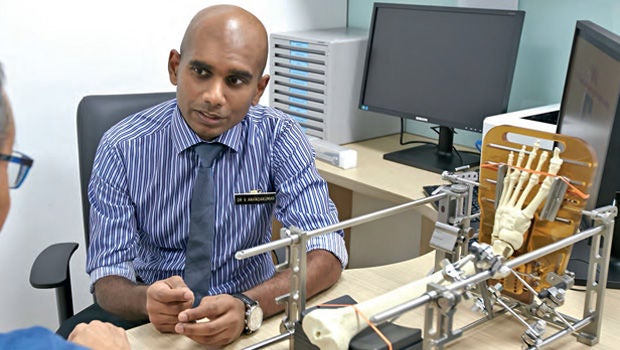
Dr Anandakumar Vellasamy explaining how the lateral total ankle replacement surgery works, using the external frame that is fitted around the patient’s ankle during surgery to ensure accurate alignment. Photo: Justin Loh
A new type of ankle surgery, known as the lateral total ankle replacement surgery, is now available at Sengkang General Hospital.
A 66-year-old engineer with severe ankle arthritis became the first patient in Singapore to receive the new lateral total ankle replacement surgery at Sengkang General Hospital (SKH).
Before surgery, he had debilitating pain from end-stage ankle arthritis. He could not walk without pain, and it affected his work and quality of life.
He went for the surgery only after medication and other conservative measures no longer provided any pain relief for him.
The surgery was done by Dr Anandakumar Vellasamy, Consultant, Department of Orthopaedic Surgery, SKH, who was trained in Switzerland and performed five such surgeries there previously.
Dr Anandakumar said total ankle replacement is a surgical option for patients over the age of 60 who have severe ankle arthritis. It involves replacing the damaged ankle joint with a prosthesis.
Traditionally, the surgery (known as the anterior approach) is done via an incision at the front of the ankle. The diseased portions of the joint are then removed and replaced with a prosthesis that mimics the functions of a normal ankle. This allows it some range of motion.
With the new method, the surgeon accesses the ankle using a lateral approach, coming in from the outer side of the ankle.
The pros and cons
The lateral approach avoids important blood vessels and nerves at the front of the ankle.
Dr Anandakumar said a unique advantage of visualising the joint from the side is that the surgeon can cut along the joint curvature, removing the diseased portions more accurately while conserving healthy normal bone. As a result, patients have a lower risk of post-surgical complications.
They also have better joint motion. “In recent large-scale studies, patients who underwent the lateral approach have shown a significant increase in the range of joint motion after surgery,” he added.
For Dr Anandakumar’s patient in SKH, retaining joint motion was important because he needed to move around in his job.
Patients usually resume normal activities six to eight weeks after surgery, and need to wait six months before engaging in strenuous activities. The ankle prosthesis lasts about 25 to 30 years.
But the new method has its shortcomings, too, said Dr Anandakumar. Compared to the traditional method, the lateral approach takes about an hour longer because an external frame must be fitted around the ankle joint for accurate realignment during surgery.
Also, approaching from the side involves cutting through the fibula bone, the slender calf bone on the lateral or outer side of the lower leg.
“Any surgery has its fair share of advantages and disadvantages. It’s a matter of selecting the right surgery for the right patient.”
Seek help early
The most common cause of ankle arthritis is usually a neglected ankle fracture or severe sprain, which damages stabilizing ligaments there.
“Over time, abnormal biomechanics of the affected joint cause certain areas of the ankle cartilage to degenerate. The lack of ankle stability from the initial injury can cause malalignment of the joint, further stressing the cartilage. This creates a vicious cycle that worsens the degeneration,” explained Dr Anandakumar.
About 1 per cent of the population suffers from this degenerative condition, which involves the wear and tear of the cartilage of the tibiotalar (ankle) joint. In severe cases, the ankle joint cartilage may be completely worn down, resulting in severe pain as joint bones grind against each other.
Dr Anandakumar said patients are first encouraged to take conservative pain relief measures, but surgical intervention may be necessary if symptoms cannot be controlled by these measures or medication. Conservative measures may include wearing comfortable shoes with modifications, calf stretching, muscle-strengthening exercises, and maintaining a healthy weight.
There are other alternative surgical methods, including ankle fusion surgery, where the joint is fused, but this method obliterates movement in the joint completely. Dr Anandakumar advises patients considering surgery to speak to their surgeon to get their perspective, as well as convey their expectations of the surgery.
“Don’t wait too long to seek an opinion as the longer the disease progresses, the stiffer the joints become, and the more difficult the surgery will be to realign the joint,” he said.













 Get it on Google Play
Get it on Google Play